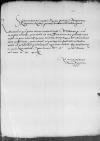Letter #2689
Sigismund I Jagiellon to Ioannes DANTISCUSWielowieś, 1543-11-27
| received Heilsberg (Lidzbark Warmiński), 1543-12-15 Manuscript sources:
| ||||
Text & apparatus & commentary Plain text Text & commentary Text & apparatus
Reverendo in Christo Patri, domino
Reverende in Christo Pater, sincere nobis dilecte.
Mittimus Paternitati Vestrae exemplar litterarum, quas dedit ad nos
illustris dominus
Quae bene valeat.
Ex
Ad mandatum regiae maiestatis proprium


 BCz, 1601, p. 490
BCz, 1601, p. 490